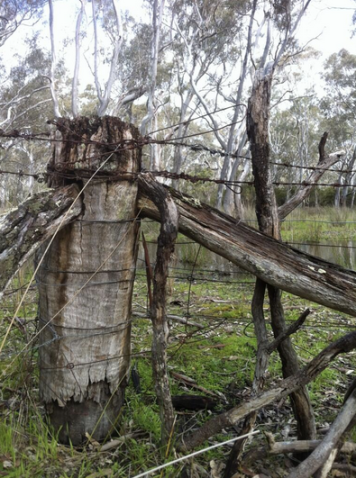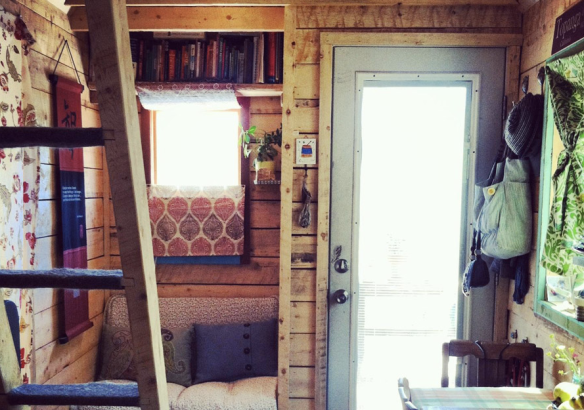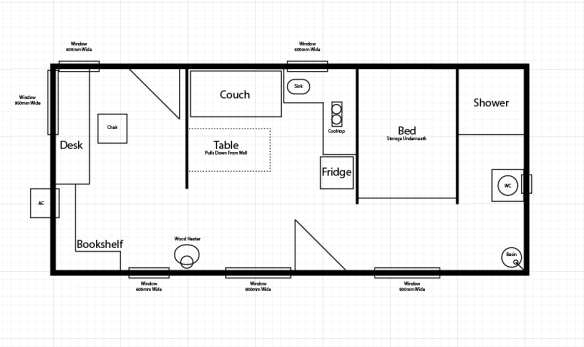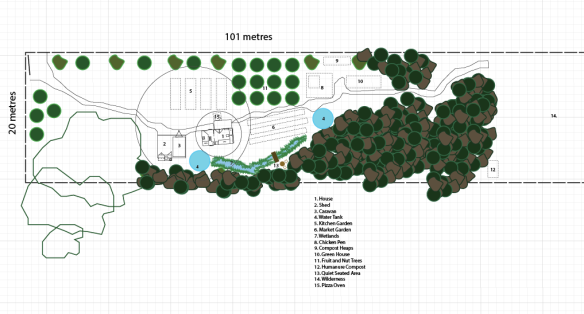In my previous post, “The Desirable World: The Beginning“, I wrote that I was going to view my first block of land this weekend. Well, I did.
As I walked over the sandy loam and sniffed in the damp air I struggled to find words to describe my impression. My partner asked, “So what do you think?” My answer was confused and mechanical. I wanted to describe my feelings accurately but without putting too much emotion in. I wanted to answer rationally. This is what was confusing and made me feel mechanical – the need to answer in this way. I was looking at a piece of earth that I may soon own, that may be a part of my journey to making a life for myself, that may become a part of me, and here I am questioning the language I ought to use to express myself. Ought to, why?

A little sneak peek of the property, looking onto the reserve.
This feeling, this internal fight, has been with me for a few weeks now. As I increasingly tell people my intentions I am made to feel that I need to be rigorously rational about this process. But why aren’t other people made to feel that way? Home ownership is core to the “Australian Dream”. One ought to aspire to home ownership, we are lead to believe. Well so say the banks. Those that rent for too long are looked at as people with poor character or poor credit. To be treated equitably, it would seem, one has to toe the line: to live the normal life. To buy a suburban block. To live with the burden of a mortgage until just before retirement. If my choice was to live that life, it would be cause for celebration. Finally I am growing up, people would hail. Welcome aboard the property latter they would say. Too emotional a decision, buying a house in the ‘burbs? Not at all. It’s a sensible move. After all, rent money is dead money John Newcombe told us – in a television commercial for new homes.
The risk I am taking is known to me. However – and a lot of people say this – I tend not to regret things if they go ‘bad’. I see failure as an opportunity. And I mean that. I have taken many risks in my life that haven’t worked out, from giving relationships a go that perhaps I shouldn’t have, to taking on huge physical adventures that fell in a heap. From each of these “failures” an opportunity was born. Failure is a positive.
But you know what, I am going to talk about it in emotional terms now. As I was emoted by the experience. I’m a human, I am susceptible to it. It was stunning. Not just the land but everything around it which would be mine too. The land only measures 3 acres but backs on to a crown-owned reserve that is huge and impenetrable. Behind the block lays an ancient creek bed which was full and alive with the sound of frogs. A couple of hundred metres to the west, a massive wetland, thick with insects and drowned timber. Nature at its best. Beautiful.
As I walked back to the car – my partner drove me on this trip – the lady that lived in the closest house came out to see what we were doing. I explained to her that I was interested in buying the block. She gave me a short history of the area, in a thick cockney accent. She told me that the rainfall this year has been very good, though late, but then shared her concerns about global warming and that that the Australian Greens party have lost their focus on their founding cause, the environment. I found myself talking to a greenie, where I thought there wouldn’t be a greenie in miles. She told me that when she and her husband first emigrated to Australia they settled in the same city where I live. But she wanted room for her horses so moved to this town. She loves it. The people are pleasant, she said. Maybe not greenies – true, considering it is a Nationals Party safe seat – but that isn’t talked about. Politics isn’t part of the conversation. There are other things to talk about like the town, the sports scene, the weather, life.
Having spoken to this dear old lady, who unfortunately lost her husband a few years ago, I feel already a part of me is connected to this place. Let’s imagine for a sec that this block of land fell through. Well that’s okay. It can happen. But I reckon this region could be the one. It is stunning. It is beautiful. I felt something. Or perhaps I am being a bit too emotional.











